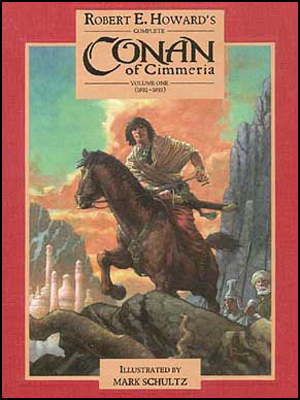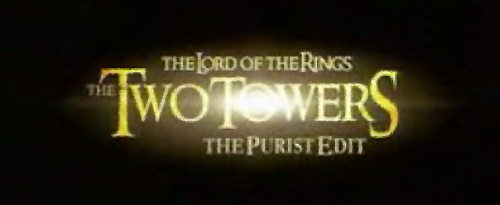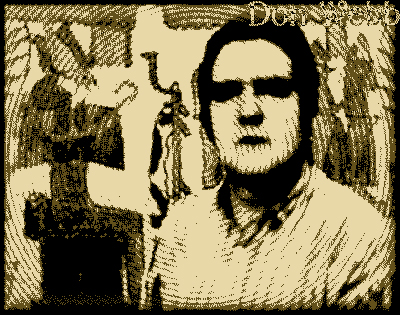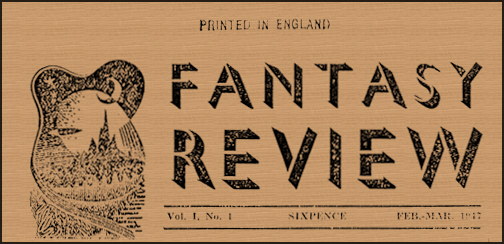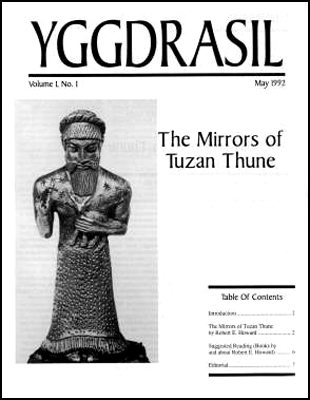
What’s Hot: Yggdrasil #1, The Howard Review, Cryptic Publications chapbooks, Writer of the Dark, Wandering Star ephemera, REHupa Mailings, Almuric.
Back on July 9, [redacted] mentioned that a virtually unknown one-shot fanzine called Yggdrasil, which was little more than a few saddle-stapled sheets, was rising past $160 on eBay. Well, the insanity of the collecting mindset never ceases: the issue ended up selling for $308.03. The “magazine” — it pains me to even use that term in this context — contained nothing more than a reprint of a frequently published tale (“The Mirrors of Tuzun Thune”) along with a sprinkling of APA-level commentary by a former REHupan. Ladies and Gentlemen, let’s put this in perspective: in 2000 the members of REHupa paid just a bit more than that for an old book that had been both owned by REH and signed to him by the book’s editor. That book, As the Poet Says–, is now sitting in the Howard House.
I’m sure Yggdrasil is a brilliant and timeless bit of ‘zine-making, but the mania of collectors who must have every little scrap of Howardiana at any price is creepy. And the scuttlebutt is that as little-known as Yggdrasil is, there is actually a fairly large universe of copies in existence, just not circulated yet. Now that The Amazing $300 Pamphlet has been mistaken for a Gutenberg bible, I’d expect to see many more appearing on eBay and changing hands. And let’s lay down odds concerning whether the collector who bought this one will soon be found dead with a gun in one hand and a bloodied Yggdrasil in the other. Every collector dreams of snagging that rare one-of-a-kind item, so why not have an opportunity to bid on “the only copy splattered with the brains of a Howard fan!!!! — A must for your collection!!!”
Howard fanzines have historically not appreciated in value that much, with occasional exceptions. Who knew that early issues of The Howard Review were in such demand? That publication’s editor, Dennis McHaney, just sold two copies of #2 together for $109.50, and this is not long after selling a copy of #3 for $547.50. The Cimmerian doesn’t have the original Howard stories, poems, and fragments that THR did, but if they appreciate even half as much I’ll cancel my 401k, secure in the knowledge that by the time I retire I’ll be able to live off of selling copies of my Awards issues with Dennis’ mug in it. “The face of the guy who made the ‘zine you paid half a G for back in 2007!!! Must own!!!”
With the REH Foundation threatening to bring all kinds of rare Howard into print, it should be interesting to see how the value of some of the old Cryptic chapbooks holds up. So far, the crappy little buggers are hangin’ in there: North of Khyber ($127.50), The Coming of El Borak ($105.50), The Adventures of Lal Singh ($100.00), Pay Day ($65.00), and The Sonora Kid ($51.00). I still remember picking up a copy of The Coming of El Borak a few years ago at the Los Angeles Paperback Show for $15. Most of them contain juvenile junk, stuff REH would be embarrassed to learn has seen print.
Other stalwarts in the arena are keeping their value. Tom Kovacs’ Writer of the Dark has just enough scarcity, collectability, and rare content to keep it selling for (as it did recently) $177.50 (I doubt his new REH book, “Winds of Time,” will have anywhere near the same cachet). REHupa mailings continue to fetch decent prices — #181 (June, 2003) went for $47.01. I maintain that the price of REHupas is going to rise as more collectors cop to the necessity of adding them to their holdings, and as loose ones are taken off the market and are increasingly no longer to be found.
A couple items surprised this week. A second printing of the 1977 Almuric paperback went for $10.27, and several pieces of Wandering Star ephemera sold big, albeit with misleading descriptions. A Conan sketchbook featuring Mark Schultz art was advertised as “EXTREMELY RARE!” when it is in fact anything but. If memory serves a few thousand of these thin and elegant little chapbooks were produced and sold cheaply for a few bucks per, and they were being handed out in such abundance that for awhile you could hardly give them away. Tell that to the guy on eBay who just bought one — unsigned, it appears — for $62.80. Another piece touted as “A MUST FOR ANY TRUE COLLECTOR!!!” is a little one-sheet (looks Xeroxed) flyer from now-defunct Wandering Star distributor Endurant Books featuring a bit of Gianni art, which sold for $22.45.
The guy selling these Wandering Star items (former REHupan David Burton, unless I miss my guess) has over time morphed into the most annoying self-promoter in the Howard field, with every scrap of paper hawked on eBay in tones usually reserved for holy relics and accompanied by more exclamation points than a Rosie O’Donnell-infested View transcript. I look forward to when he gets around to selling the terrible drawing of Conan he did for REH: Two-Gun Raconteur #7, one that he could advertise truthfully as “THE FIRST CONAN WITH SIX FINGERS!!!” You can’t make this stuff up. As Indy Cavalier said in REHupa at the time, “Now we know who really killed Inigo Montoya’s father.”
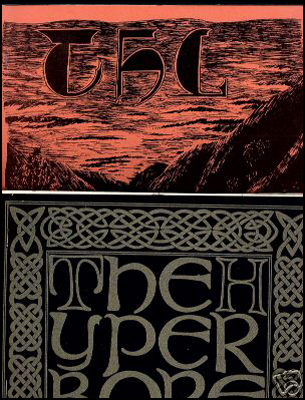
What’s Cold: The Hyperborean League, The Last Celt, Howard Boom era paperbacks, Grant Conan hardcovers, The Dark Man #1, Baen series paperbacks, Amra, Del Rey Kull.
The Hyperborean League is not as known as it should be. Created in the 1970s by Don Herron and an assortment of talented REHupans disgruntled at the direction (or lack thereof) of the REH a.p.a., it splintered off from REHupa proper and released mailings of much higher quality than REHupa was doing at that time. Eventually REHupa got better, and The Hyperborean League folded back into it, but until that happened THL put out some great, collectible mailings. Glenn Lord’s zines were so good that they later were collected in book form as Glenn Lord’s Ultima Thule. These mailings are more rare than REHupas, more packed with Howard content, and they are seldom seen on the open market. Strange then to see one put up on eBay by Cimmerian reader Lee Breakiron and yet not sell for the listed price of $75.00. That’s relatively cheap considering what many REHupas, much more recent and much less scarce, have been going for. (And contrary to Lee’s comment in the listing that the gents “couldn’t spell Hyperborian,” the spelling is in fact correct — both REH and CAS used “Hyperborea”).
Glenn Lord’s The Last Celt has lost a bit of steam over the years, perhaps due to so much of its contents appearing in other arenas, and to its Bibliography finally being supplanted by Howard Works and now The Neverending Hunt. Whereas before a decent hardcover version of the book would sell for $50-$100 every time, now we see some copies going unsold (the latest failed to find a purchaser at $60).
The paperbacks from the Howard Boom era (1966-1983) remain in the basement of the Howardian Collecting House due to the huge number of copies floating around and the superseding of most of them by various Wildside and Del Rey hardcovers. For those of you just discovering REH, buying a large lot of paperbacks on eBay for $25 or so is the easiest way to introduce yourself to a lot of new REH quickly and cheaply. I love the smell of that browned brittle paper, too — reminds me of Howard’s descriptions of “breath like a whisper from the past, laden with musk, scents of forgotten things, breathing secrets that were hoary when the world was young.”
We can throw the Baens into the basement as well at this point. There was a time not so long ago when they looked like they might scratch and scramble up to a higher level of collectability. Some copies were selling for as much as $25. But that was then, before Del Rey eliminated the need for at least three of the volumes, and before the shoddy paper they were printed on began browning on even otherwise pristine copies. While you can find independent booksellers trying to sell complete sets of the Baens for $200 and up (sometimes way up), a savvy collector with patience and an eagle eye can procure them for as low as $1 each. Copies advertised for as low as $3 aren’t even getting any bids on eBay. Time has not been kind to this series on a number of fronts, and it will probably get worse over the next few years as more books come out (such as the Del Rey horror volume) that reduce the need for them on the average REH fan’s shelf.
What’s more alarming lately is how cheap the Del Rey trade paperbacks are going for. Even the Kull book, released just last November, can be had for $3 and shipping. I hope this isn’t an indication that they are selling poorly, but of course it probably is. Heck, a hardcover edition of the book, put out by the Science Fiction Book Club, sold recently on eBay for a paltry $1.29. Granted, SFBC tomes are printed on awful paper and have fairly shoddy construction, as I discovered when first handling them at last year’s World Fantasy Convention. I’d love to have the Del Rey’s in hardcover, but not with that paper.
One set of hardcovers that may be an eerie precursor to the ultimate fate of the deluxe Wandering Star editions is the Donald Grant set of Conan books from the 1970s. Billed at the time as a deluxe set, with illustrations and good construction, the set was marred by bad art, textual errors, and its incomplete status, and even though the large font makes them more pleasant to read than any other edition of Conan, their prices at auction are perilously low, hovering around the $20-$30 range for most titles. A few guys on eBay keep trying to unload these at $45 and up, and it just ain’t happening, the auctions almost always end without a single bid.
And lastly, while McHaney is raking in big bucks for his old publications, other old fanzines are struggling in the marketplace. A copy of The Dark Man #1 failed to sell at a $10 asking price, and several copies of Amra from much earlier aren’t selling for less. What this portends if anything is anyone’s guess, but I think it could be a sign that as the market becomes flooded with byproduct, collectors are going to grow more selective about what they “need” to collect. Printing quality may play an increased role in what gets bought, too.
Independent Booksellers

Leaving eBay behind and looking towards the more expensive and hard-nosed independent booksellers, we are reminded that in collecting Rarity is King. This is amply demonstrated by the advertised prices for the Wandering Star Leather Editions, most printed in limited editions of around fifty copies:
The Savage Tales of Solomon Kane Leather Edition: $4008.60
Bran Mak Morn: The Last King Leather Edition: $1541.77
Conan of Cimmeria I and II Leather Editions: $1428.70 ea.
Well, good for them I guess, but the fan on the ground is left to wonder whether there would be enough dough in the WS coffers to print Conan III if the hide used to make these books had been left on the cows and goats.
Even as the Grants sit in the doldrums of REH collecting, the Gnomes still pack a punch. A complete Gnome Press Conan Set on one site is going for $3300.00. A fairly outrageous price, but for a fine or very fine set all in one place, there’s a chance someone will snatch it up. Arkham House’s Always Comes Evening: is also occupying a place of honor in the REH collecting starscape. One copy I spied is listed at $3000.00. Not bad for a book that Glenn Lord barely got published fifty years ago.
The REH Collecting Legacy of Leon Nielsen
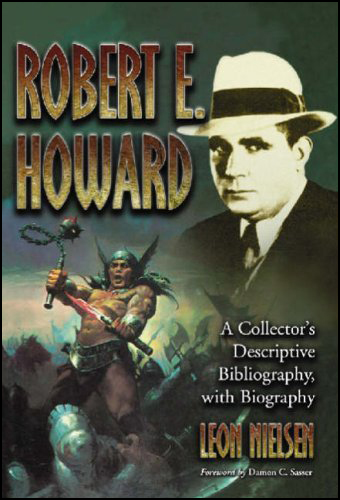
With the death of Leon Nielsen, let us pause to consider his book on collecting REH. There have been complaints — “no Frazetta illos, typos, guessimated prices that are now out-of-date” — but I think they are overblown. Especially for a new collector getting his feet wet, the book gives a really detailed overview of the scene, taking the time to point out all sorts of details that most other sources take as read. Grading is discussed, as are a variety of collecting terms, and the knowledge is then applied to REH specifically. The biographical information is solid and well-expressed, and the various lists of things to collect depending on your interest and focus are fun and useful. Leon sent me a signed copy last January, and although I’m not a collector myself I’m glad he did. I’ve referenced it time and again, and think that long hence it will take on the aura of a snapshot of the collecting universe of REH in our era, one that future generations will find fascinating.
Things to Watch
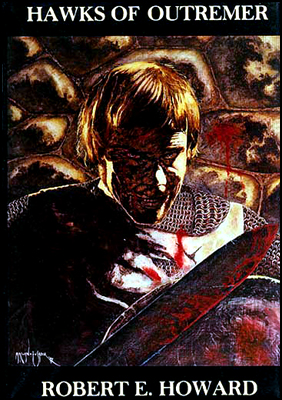
HAWKS OF OUTREMER: This was always one of the more expensive hardcovers from the 1970s, but it was recently superseded by the Bison released Lord of Samarcand. So the question is, will it continue to command prices of $50-$100? There’s a copy on eBay now listed for $79.95, so let’s watch and find out. My prediction? Not a chance in hell it will sell for that price.
LEWD TALES: Another crappy Cryptic Chapbook — will it match the performance of the ones sold last week? Probably. If it hits $50, then Cryptic is still the bomb.
FANTASTIC WORLDS OF ROBERT E. HOWARD: For me, this book has been steadily falling in prestige over the last few years. The copy currently on eBay is advertised as containing “the best of REHupa” from that era. Partly that’s correct, the book does have some good items in it. But there are also some unconscionable stinkers in the mix, and combined with the comic sensibilities at play in the layout and much of the art, I don’t think it holds up. A first printing is listed for $25 — I can’t see it selling at that price.
THE HOWARD REVIEW #1: McHaney struck gold with #3 and to a lesser but still impressive extent with #2. Will a copy of #1 match or exceed that haul? My guess is yes. The sharks are circling, and there is still blood in the water from the last few McManiac auctions. This one should be fun to watch at the close, and the next time I’m in Austin Dennis is buying the drinks for sure.
CROSS PLAINS UNIVERSE: There was a short burst of interest and activity swirling around this book last November after its debut at the World Fantasy Con. Many people who hadn’t attended the con wanted a copy, some who had purchased supporting memberships hadn’t received their complimentary copy, and books were in play with different signatures attached to them. The one on eBay now sports three sigs and is listed at $9.99. I think it has to go to someone at that minimum, but who, and at what final cost, is anyone’s guess. I’ll go out on a limb and say that it’ll net $30+.
REHupa #183: Another fairly recent issue. Years ago copies would generally go for $20. Lately this has changed dramatically, and I think permanently, and you usually see them hitting $50 and often $100 and more. $200 and up is not out of the question for these as a bit more time passes, especially if interest in REH is peaked by new Hollywood fare, bringing in new waves of fresh collectors looking to establish a beachhead in Howardia. I’ll predict this one to go for $50, but wouldn’t be surprised (or feel the buyer had been cheated) if it goes for twice that.
Proof to THE BLOODY CROWN OF CONAN: This item is interesting, in that galleys and proofs sometimes fetch high prices, depending on author and title. I know that at Howard Days a few years back I convinced the Del Rey guys to donate a few to the silent auction, and they sold for pretty major money, $100 and up. Of course that was before at least one of the books had been released yet, so the buyer was getting a bonafide preview of an unreleased volume. I don’t see eBay being an environment conducive to this going for a lot of money, at least without a signature on it or an artist’s doodle.
SWORD WOMAN: first printing of this paperback, one that usually fetches at least a few bucks more than the ocean of other REH paperbacks washing up on eBay’s colorful shores. $3.00 as an opener isn’t a deal breaker, especially if it’s in pretty good condition. Heck, I might drop a bid on it myself.
ROB ADDS: Part of the reason, I’m sure, that the Cryptics continue to sell well is the fact that they contain REH fiction that is not available anywhere else. Sure, the Bran Mak Morn play from Bran Mak Morn: A Play & Others was included in the Wandering Star/Del Rey collection, but not “The Black Moon,” a Steve Harrison story; that Cryptic book is still the only place to find it. And the same is true with the others, each one contains something that can’t be found any place else. The only Cryptic book that is entirely superfluous is Lewd Tales, thanks to the Collected Letters of REH Vol. 1, which includes all three of the items from that old chapbook.


